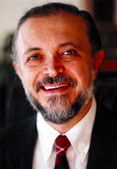2002 John P. McGovern Science and Society Award
Mario J. Molina and two colleagues shared the 1995 Nobel Prize in Chemistry for their work in explaining the chemical mechanisms in the atmosphere that affect the thickness of the ozone layer. In the process, they helped society avert a global environmental problem with potentially catastrophic consequences. Born in Mexico City in 1943, Molina was fascinated by science at an early age and converted a spare bathroom in his family's home into a laboratory. By the time he went off to boarding school in Switzerland at age 11, he had already decided to become a research chemist. As a postdoc at the University of California at Irvine, he and F. Sherwood Rowland developed their now famous "CFC-ozone depletion theory," bringing the issue to the attention of fellow scientists and the public. Molina later joined the Jet Propulsion Laboratory and, in 1989, moved to the Massachusetts Institute of Technology, where, as MIT Institute Professor, he has continued his research on global atmospheric chemistry issues. He is a member of the National Academy of Sciences, the Institute of Medicine and the Pontifical Academy of Sciences. Most recently, Molina has been working with colleagues from many other disciplines on the problem of severe air pollution in rapidly growing urban areas, with an initial focus on Mexico City.